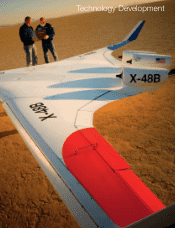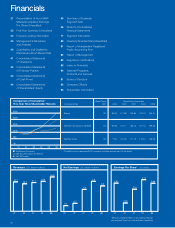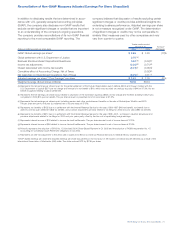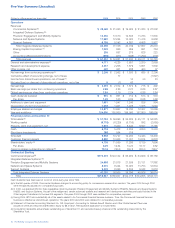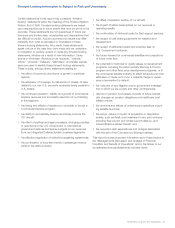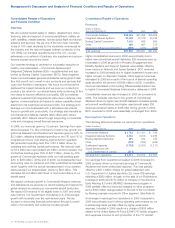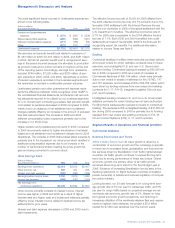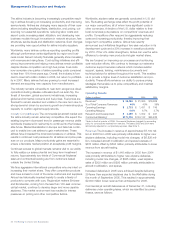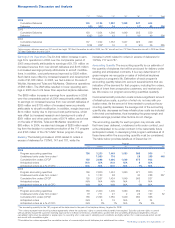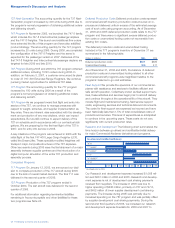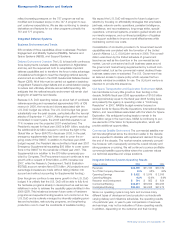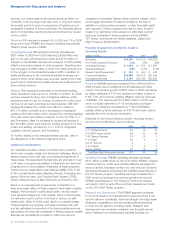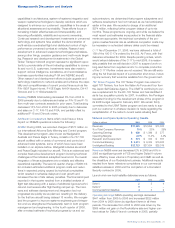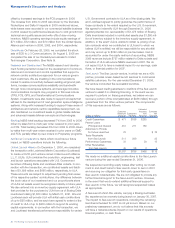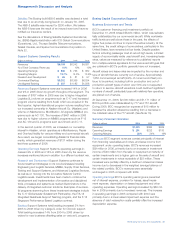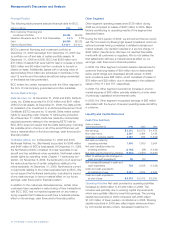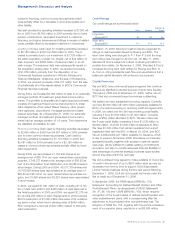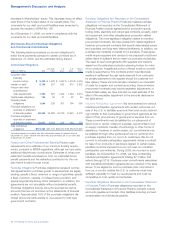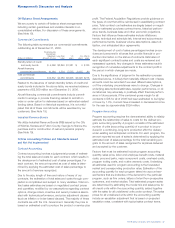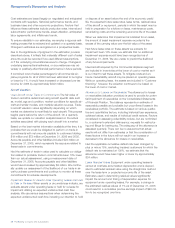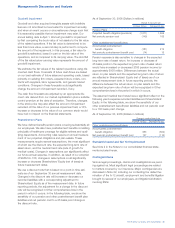Boeing 2006 Annual Report Download - page 31
Download and view the complete annual report
Please find page 31 of the 2006 Boeing annual report below. You can navigate through the pages in the report by either clicking on the pages listed below, or by using the keyword search tool below to find specific information within the annual report.
reflect increasing pressures on the 787 program as well as
modified and increased scope on the 747-8 program to sup-
port customer expectations. We are also continuing to develop
derivatives and features for our other programs primarily the
737 and 777 programs.
Integrated Defense Systems
Business Environment and Trends
IDS consists of three capabilities-driven businesses: Precision
Engagement and Mobility Systems (PE&MS), Network and
Space Systems (N&SS), and Support Systems.
Defense Environment Overview The U.S. is faced with continuous
force deployments overseas, stability operations in Afghanistan
and Iraq, and the requirement both to recapitalize important
defense capabilities and to transform the force to take advantage
of available technologies to meet the changing national security
environment as outlined in the 2006 Quadrennial Defense Review
Report (QDR). All of this must be carried out against a backdrop
of significant Federal budget deficits and an administration pledge
to reduce and ultimately eliminate annual deficit spending. We
anticipate that the national security environment will remain chal-
lenging for at least the next decade.
Because U.S. DoD spending makes up about half of worldwide
defense spending and represented approximately 84% of IDS
revenue in 2006, the trends and drivers associated with the
U.S. DoD budget are critical. The U.S. DoD budget has grown
substantially over the past decade, particularly after the terrorist
attacks of September 11, 2001. Although the growth rate had
moderated in recent years, the 2008 submittal equates to an
11% increase over the projected 2007 enacted level. The
President’s request for fiscal year 2008 is $481 billion, excluding
the additional $142 billion request to continue the fight in the
Global War on Terror (GWOT) in fiscal year 2008. In the past,
emergency supplementals had been used to cover the on-
going costs of the GWOT. In addition to the fiscal year 2008
budget request, the President also submitted a fiscal year 2007
Emergency Supplemental requesting $93 billion to cover opera-
tions in the GWOT for the remainder of fiscal year 2007. This
Supplemental is in addition to the $70 billion previously pro-
vided by Congress. The Procurement account continues to see
growth with a request of $102 billion, a 25% increase over
2007, while the Research, Development, Test & Evaluation
(RDT&E) account remains flat at $75 billion. (All projections and
percentage increases are made without taking inflation into
account and without accounting for Supplemental funding.)
Even though we continue to see some growth in the U.S. DoD
budget, it is unlikely that the U.S. DoD will be able to fully fund
the hardware programs already in development as well as new
initiatives in order to address the capability gaps identified in the
2006 QDR. This imbalance between future costs of hardware
programs and expected funding levels is not uncommon in the
U.S. DoD and is routinely managed by internally adjusting priori-
ties and schedules, restructuring programs, and lengthening
production runs to meet the constraints of available funding.
We expect the U.S. DoD will respond to future budget con-
straints by focusing on affordability strategies that emphasize
jointness, network-centric operations, persistent intelligence,
surveillance, and reconnaissance, long-range strike, special
operations, unmanned systems, precision guided kinetic and
non-kinetic weapons, and continued privatization of logistics
and support activities to improve overall effectiveness while
maintaining control over costs.
Consolidation of contractor-provided U.S. Government launch
capabilities was completed with the formation of the United
Launch Alliance L.L.C. (ULA) joint venture in 2006. This consoli-
dation was driven by the limited schedule of government
launches as well as the downturn in the commercial launch
market. Launch contractors had built business cases around
the government market being supplemented by a robust com-
mercial market, but as the commercial market declined these
business cases were re-evaluated. The U.S. Government has
an assured access to space policy which requires that two
separate vehicles be available for use. The ULA joint venture is
intended to provide this assurance.
Civil Space Transportation and Exploration Environment NASA
has had stable but very little growth in their funding in this
decade. NASA’s fiscal year 2006 appropriation of $16.6 billion
was approximately equal to the fiscal year 2005 funding level,
and presently the agency is operating under a “Continuing
Resolution” in 2007. NASA’s budget remains focused on
needed funds for Space Shuttle Operations, International Space
Station, and new initiatives associated with the Vision for Space
Exploration. We anticipate funding levels to remain in the
$16 billion range in the near future. NASA is continuing to pur-
sue elements of the Vision for Space Exploration, which will
provide additional opportunities.
Commercial Satellite Environment The commercial satellite mar-
ket has strengthened since the downturn earlier in the decade
and is expected to stabilize with replacement demand through
the end of the decade. The market remains extremely competi-
tive however, with overcapacity across the overall industry and
strong pressure on pricing. We will continue to pursue profitable
commercial satellite opportunities where the customer values
our technical expertise and unique solutions.
Integrated Defense Systems Operating Results
(Dollars in millions) 2006 2005 2004
Revenues $32,439 $31,106 $30,739
% of Total Company Revenues 53%58%60%
Operating Earnings $÷3,032 $÷3,919 $÷2,936
Operating Margins 9.3%12.6%9.6%
Research and Development $÷÷«791 $÷÷«855 $÷÷«834
Contractual Backlog $42,291 $36,505 $39,296
Unobligated Backlog $33,424 $44,008 $47,472
Since our operating cycle is long-term and involves many
different types of development and production contracts with
varying delivery and milestone schedules, the operating results
of a particular year, or year-to-year comparisons of revenues
and earnings, may not be indicative of future operating results.
In addition, depending on the customer and their funding
The Boeing Company and Subsidiaries 29
Management’s Discussion and Analysis


